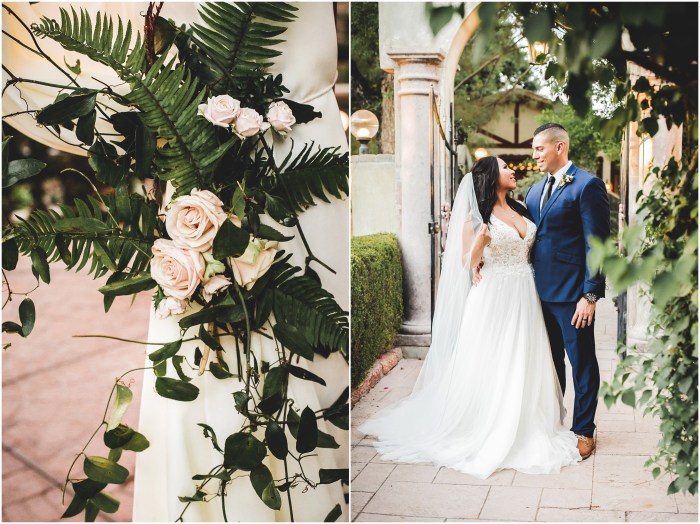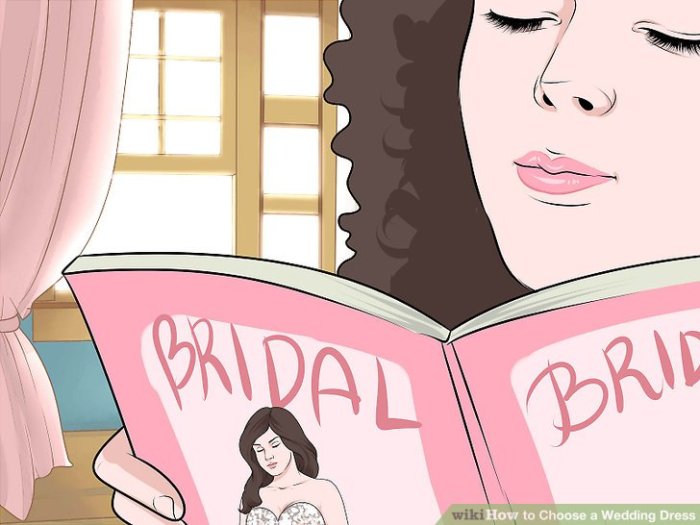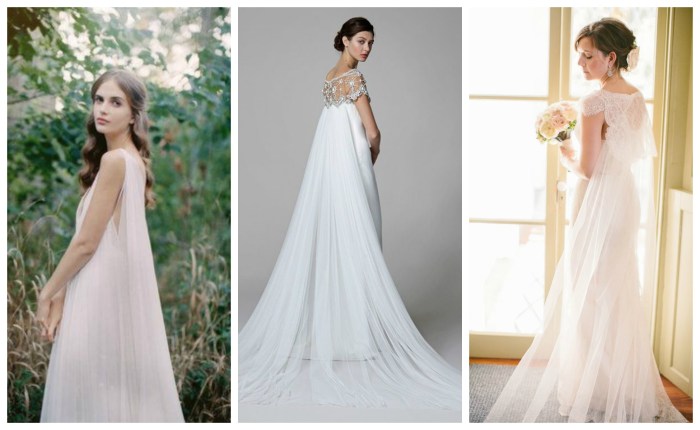Understanding Your Body Shape and Style
How to pick a wedding dress – Choosing a wedding dress that flatters your body shape is crucial for feeling confident and radiant on your special day. Understanding your body type allows you to select silhouettes, necklines, and fabrics that enhance your natural features. This section will guide you through identifying your body shape and selecting the most appropriate dress styles.
Body Shapes and Flattering Necklines
Different body shapes are generally categorized as hourglass, pear, apple, rectangle, and inverted triangle. Each shape benefits from different silhouettes and necklines. For instance, an hourglass figure, characterized by balanced bust and hip measurements, looks stunning in A-line, fit-and-flare, and mermaid gowns. A pear shape, with wider hips than bust, is beautifully complemented by A-line or ballgown dresses that balance the proportions.
Choosing your wedding dress involves considering your body type, venue, and personal style. One stunning option that beautifully balances elegance and allure is a high neck open back wedding dress, like those you can find at high neck open back wedding dress retailers. Ultimately, the best dress is the one that makes you feel confident and radiant on your special day, so don’t be afraid to experiment with different silhouettes and styles until you find “the one”.
Apple shapes, with a fuller midsection, often find that empire waistlines or V-necklines create a flattering illusion. Rectangle body types, with similar bust, waist, and hip measurements, can experiment with various styles, including sheath, A-line, and fit-and-flare dresses. Inverted triangle shapes, with broader shoulders than hips, look best in dresses that add volume to the lower body, such as A-line or ballgown styles.
Wedding Dress Silhouettes and Body Types
| Body Shape | Flattering Silhouettes | Necklines to Avoid | Necklines to Emphasize |
|---|---|---|---|
| Hourglass | A-line, Fit-and-flare, Mermaid, Empire waist | High necklines, Halter necks (can overwhelm) | Sweetheart, V-neck, Plunging necklines |
| Pear | A-line, Ballgown, Empire waist | Mermaid, Straight, Bodycon (emphasize hips) | V-neck, Sweetheart, Off-the-shoulder |
| Apple | Empire waist, A-line, Ballgown | High necklines, Strapless (can draw attention to midsection) | V-neck, Sweetheart, Plunging necklines |
| Rectangle | Sheath, A-line, Fit-and-flare, Mermaid | None particularly, experiment to find what suits you best | All necklines can be explored |
| Inverted Triangle | A-line, Ballgown, Empire waist | Strapless, Halter necks (emphasize shoulders) | V-neck, Sweetheart, Boat neck |
Fabric Choice and Body Shape

Source: photobiz.com
Fabric choice significantly impacts how a dress looks on different body shapes. Heavier fabrics like brocade or satin can add volume, while lighter fabrics such as chiffon or tulle create a more flowing silhouette. For example, a structured fabric like crepe can be very flattering on a pear-shaped body, providing shape and definition, whereas a flowing fabric like chiffon can beautifully drape over an apple shape, softening the midsection.
Understanding these nuances can help you choose fabrics that enhance your figure.
Defining Your Wedding Style and Theme
Your wedding style and theme should be a cohesive reflection of your personality and the overall atmosphere you envision for your special day. The venue plays a significant role in dictating the appropriate dress style, while your chosen theme further refines the look. This section explores the connection between venue, theme, and dress style, providing examples to inspire your choices.
Wedding Venue and Dress Style
A beach wedding naturally calls for a flowing, lightweight gown, perhaps in a bohemian or romantic style. A formal ballroom wedding, on the other hand, might suit a more structured, classic, or glamorous gown. A rustic barn wedding lends itself to a more relaxed, romantic, or bohemian style dress. The architecture, décor, and overall ambiance of your chosen venue will guide you towards the most appropriate dress silhouette and aesthetic.
Wedding Themes and Dress Styles
- Rustic: Lace, flowy fabrics, natural embellishments, romantic silhouettes.
- Bohemian: Flowing fabrics (chiffon, lace), intricate detailing, relaxed silhouettes.
- Classic: Clean lines, structured silhouettes (sheath, A-line), elegant fabrics (satin, silk).
- Modern: Sleek silhouettes, minimalist designs, geometric details, unique fabrics.
- Glamorous: Luxurious fabrics (silk, satin), embellishments (beading, sequins), dramatic silhouettes.
Wedding Dress Looks for Different Venues
- Beach Wedding: A flowing A-line gown in lightweight chiffon, adorned with delicate lace appliqués. The overall aesthetic would be romantic and effortless, with minimal embellishments to keep the look breezy and comfortable.
- Formal Ballroom Wedding: A classic ballgown in luxurious satin, featuring intricate beading and a sweetheart neckline. The overall aesthetic would be glamorous and elegant, with a focus on sophisticated details.
- Rustic Barn Wedding: A romantic A-line gown in lace, with delicate floral embroidery and a flowing train. The overall aesthetic would be relaxed and charming, with natural elements incorporated into the design.
Choosing the Right Fabric and Details: How To Pick A Wedding Dress
The fabric and embellishments you choose significantly impact the overall look, feel, and comfort of your wedding dress. This section provides a detailed comparison of different fabrics and embellishments, helping you make informed decisions based on your style, budget, and the season of your wedding.
Wedding Dress Fabrics
Lace offers intricate detailing and a romantic feel, while satin provides a sleek, luxurious look. Tulle is lightweight and airy, perfect for creating volume, and silk is a luxurious, versatile fabric with a beautiful drape. Each fabric has unique characteristics regarding texture, drape, and suitability for different seasons and venues. For instance, heavier fabrics like satin or brocade are more suitable for cooler seasons or formal settings, while lighter fabrics like chiffon or tulle are ideal for warmer weather or outdoor ceremonies.
Embellishments and Their Impact
Beading adds sparkle and glamour, embroidery provides intricate detail and texture, and appliqués offer a unique design element. The choice of embellishments should complement the overall style of the dress and the wedding theme. For example, delicate beading might be perfect for a romantic gown, while bold embroidery could suit a more modern or bohemian style.
Fabric Comparison
| Fabric | Pros | Cons | Suitable Season |
|---|---|---|---|
| Lace | Romantic, intricate detail, breathable | Can be delicate, may require more care | Spring, Summer, Autumn |
| Satin | Luxurious, sleek, drapes well | Can be less breathable, shows imperfections | Autumn, Winter |
| Tulle | Lightweight, airy, creates volume | Can be easily damaged, may require layering | Spring, Summer |
| Silk | Luxurious, drapes beautifully, breathable | Can be expensive, requires careful care | All seasons (depending on weight) |
Budget and Shopping Strategies
Setting a realistic budget and developing a smart shopping strategy are essential for finding the perfect wedding dress without exceeding your financial limits. This section provides guidance on budgeting, finding affordable options, and comparing different shopping methods.
Setting a Wedding Dress Budget, How to pick a wedding dress
- Determine your overall wedding budget.
- Allocate a percentage for the dress (typically 10-15% of the total budget).
- Consider additional costs (alterations, accessories).
- Set a firm spending limit and stick to it.
Tips for Finding Affordable Wedding Dresses
- Shop during off-season sales.
- Consider sample sales or trunk shows.
- Explore online retailers and consignment shops.
- Look for dresses with less embellishment.
- Be open to different styles and fabrics.
Comparing Shopping Methods
Bridal salons offer personalized service and expert advice, but can be more expensive. Online retailers offer convenience and a wider selection, but lack the personalized experience. Consignment shops provide affordable options, but selection may be limited. Weighing the pros and cons of each method will help you choose the best approach for your needs and budget.
Accessorizing and Completing the Look
Accessories play a vital role in completing your wedding day look, enhancing your dress and reflecting your personal style. This section discusses the importance of selecting the right accessories, including veils, jewelry, shoes, and undergarments.
Complementary Accessories
Veils can add elegance and drama, while jewelry should complement the neckline and overall style of the dress. Shoes should be comfortable and stylish, coordinating with the dress and venue. The choice of accessories should be carefully considered to create a cohesive and polished look. For example, a cathedral-length veil might pair beautifully with a classic ballgown, while a simple birdcage veil could complement a more modern or bohemian dress.
Undergarments and Seamless Fit
Choosing the right undergarments is crucial for a smooth and flattering silhouette. Seamless shapewear can help create a streamlined look, while a well-fitting bra ensures proper support and prevents visible lines under the dress. Consider the fabric and style of your dress when selecting undergarments to ensure a comfortable and flawless fit.
Accessory Selection Process
Start by considering the style and silhouette of your dress. Then, choose accessories that complement the dress without overpowering it. Consider the overall theme and venue of your wedding, ensuring that your accessories align with the overall aesthetic. Finally, select accessories that reflect your personal style and preferences.
The Dress Alterations Process
Professional alterations are essential to ensure a perfect fit and enhance the overall look of your wedding dress. This section details the importance of alterations, common alterations needed, and tips for finding a reputable seamstress or tailor.
Importance of Professional Alterations

Source: wikihow.com
Alterations ensure the dress fits perfectly, enhancing your comfort and confidence on your wedding day. A properly altered dress will look more flattering and tailored to your body shape. Common alterations include adjustments to the length, bust, waist, and shoulders.
Common Alterations and Costs
Typical alterations include hemming, taking in the waist or sides, adjusting the bust, and adding or altering straps. The cost of alterations varies depending on the complexity of the adjustments and the location. It’s advisable to budget for alterations when planning your wedding dress expenses.
Finding a Reputable Seamstress
Seek recommendations from friends, family, or wedding professionals. Check online reviews and portfolios to assess their experience and skill. Schedule consultations to discuss your needs and get a quote before making a decision. Ensure you feel comfortable and confident in their abilities before entrusting your dress to them.
Visual Inspiration and Design
Understanding different wedding dress silhouettes and sleeve styles can significantly influence your choice. This section provides detailed descriptions of various silhouettes and sleeve styles, including their visual effects and suitability for different body types and wedding themes.
Wedding Dress Silhouettes

Source: azazie.com
A-line dresses offer a flattering and versatile silhouette, suitable for most body types. Ballgown dresses create a dramatic and romantic look, perfect for formal weddings. Sheath dresses are sleek and modern, emphasizing the body’s natural shape. Mermaid dresses hug the body and flare out at the knees, creating a glamorous and figure-hugging silhouette. Empire waist dresses are flattering on various body types, accentuating the waistline and creating a flowing skirt.
Each silhouette creates a unique visual effect and is suitable for different body types and wedding themes.
Sleeve Styles and Their Impact
Sleeveless dresses offer a classic and elegant look, while long sleeves provide coverage and a more formal feel. Short sleeves add a touch of femininity and can be versatile for various themes. Off-the-shoulder sleeves create a romantic and elegant look, while cap sleeves offer a delicate touch of coverage. Each sleeve style creates a unique visual effect and is suitable for different body types and wedding themes.
For instance, long sleeves might be more appropriate for a winter wedding, while sleeveless dresses might be better suited for a summer ceremony.
Questions Often Asked
What is the average cost of a wedding dress?
The average cost varies greatly depending on designer, fabric, and embellishments, ranging from a few hundred to several thousand dollars.
How far in advance should I start shopping for my wedding dress?
Ideally, begin shopping 9-12 months before your wedding to allow ample time for alterations and potential delays.
Should I bring anyone with me when I shop for my wedding dress?
Bring a small, supportive group of trusted friends or family members whose opinions you value. Too many opinions can be overwhelming.
How many wedding dresses should I try on?
There’s no magic number, but try on a variety of styles to discover what you like and dislike. Be open-minded and don’t be afraid to step outside your comfort zone.
